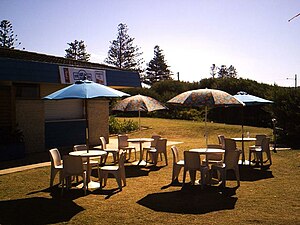I learned to love the water amid the red dirt and cotton silos of the NSW outback.
 Image via WikipediaMy family arrived here from Ireland in late 1967, swapping an icy winter for a parched summer in Sydney's west. Those first few months were so hot and dry my parents thought it would never rain again.
Image via WikipediaMy family arrived here from Ireland in late 1967, swapping an icy winter for a parched summer in Sydney's west. Those first few months were so hot and dry my parents thought it would never rain again.My mother parked my baby sister's pram in the cement-floor bathroom - the coolest room in the house - and introduced my four siblings and me to our local swimming pool.
The first visit was inauspicious, to put it mildly. In those days, there were few warnings about the need for sunscreen, no neck-to-calf sunsuits that paranoid parents shroud young children in today. Mum assumed her pale-skinned brood, then aged from one to seven, would be fine because the day was overcast. Alas, by the time we got home, we were the colour of smoked salmon. We stayed indoors for several days afterwards, dressed only in our undies and wet towels.
Nevertheless, for me, this would mark the beginning of a long and unfashionable love affair with municipal swimming pools. For thousands of Australians in outer suburbs and country towns, the essence of summer is a concrete and tile box reeking of chlorine, rather than the fabled coast, because that is where we learned to conquer the water.
I remember my first dive off the blocks, and the summer I mastered backward somersaults without the water going up my nose, as vividly as surfers remember the first time they danced to shore on a wave.
In the early 1970s my family moved to Wee Waa, about 600km northwest of Sydney, after Dad secured work digging trenches that would help deliver an unheard-of luxury to the cotton-growing town: a flush toilet in every home. We could walk to the local pool and my mother booked us in for swimming lessons. As usual, I failed to keep up with my brothers and needed an extra set.
I was almost nine and deeply ashamed of the fact I couldn't swim. Yet within weeks, I was so at ease in the water my siblings and
I regularly took ourselves to the pool after school. This would have never happened in the city.
For me, being free and fast and impossibly light in the water was liberating in a way no other pastime had been, and when we returned to Sydney my parents flung up the biggest above-ground pool they could find.
Mum and Dad couldn't swim, and didn't exactly rush into initiating their five kids into Australia's celebrated surf culture. In fact, after migrating here it took them five years to get around to taking us to the beach. My mother's explanation for this seems inadequate at the same time as it rings true. "It wasn't something people out this way did," she insists. "Out this way" was Sydney's outer western suburbs. It was hardly the outback, but to my parents the beach was beyond the city centre and, hence, another country.
Our family finally made it to the beach in 1972. I remember arriving at Coogee in Sydney's east about midday; the sand was like hot coals and the thunderous break that thumped the shore scared the living daylights out of me.
When I was an adolescent, we started going to NSW's central coast for the Christmas holidays. At first, we tried camping, but the tent almost blew away in a coastal gale - we were in it at the time.
The next year, we splashed out and bought a caravan. We parked it in the yard of a holiday house owned by another Irish family. Altogether, there were 14 people on one suburban block. The neighbours must have thought us the equivalent of a Roma Gypsy clan, but didn't seem to mind.
My dad refused to bow to the basics of beach etiquette. He still couldn't swim. He had deeply tanned arms from working outside but bluish-white legs because he didn't believe in shorts. (He considered that wearing shorts, like taking a daily shower, was a ridiculous Australian affectation.)
He went to the beach in his mass clothes: gaberdine trousers, collared shirt, shoes and socks. If he forgot to bring a sunhat, he would wear mine, revelling in my teenage mortification.
Of course, no Christmas break was complete without the ritual traffic gridlock, as half the city fled the suburbs for the coast. Mum reckons the breakdown lane on the freeway heading north was like a reunion; we'd often meet other Irish families we knew, stranded by the roadside in their dodgy, overheating second-hand cars.
These days I take my kids on beach holidays a couple of times a year. They love testing themselves against the waves; the pull and push and thrilling unpredictability of the surf.
Yet for me, the defining episode of my childhood summers will always be the year I kicked away from the sides of the Wee Waa pool and plunged down, without fear, to touch the bottom of the deep end.





